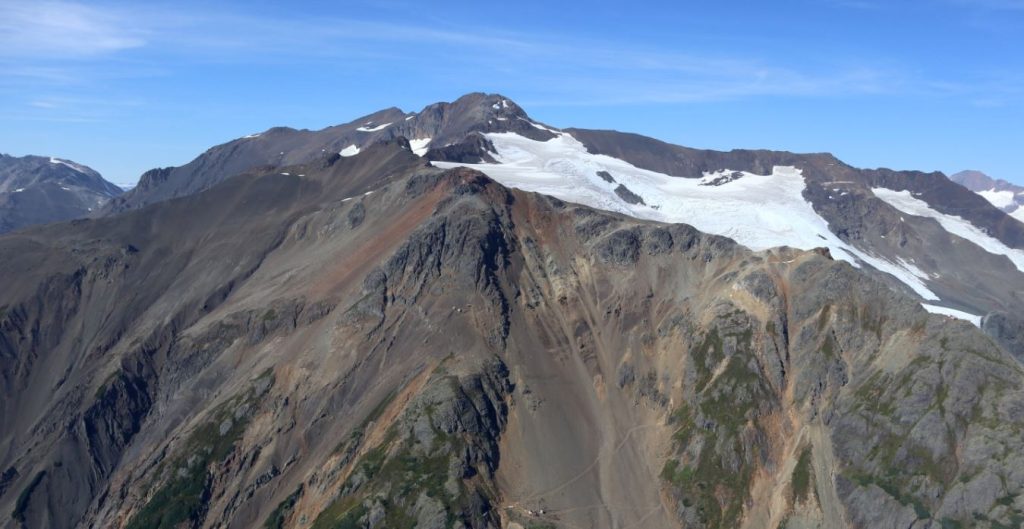Garibaldi Resources drills nickel mineralization at E&L, British Columbia

Garibaldi Resources Corp.‘s [GGI-TSXV; GGIFF-OTC; RQM-FSE] diamond drill hole EL-22-97b has intersected nickel-bearing disseminated and semi-massive sulphide mineralization. The mineralization is hosted by taxitic and orbicular-textured gabbro and pyroxene peridotite 205 metres down-trend of the previous deepest mineralized intercept at 100%-owned E&L project on Nickel Mountain in the Golden Triangle region of northwestern British Columbia.
The drill hole targeted the down plunge extension of the eastern zone of the E&L Intrusion, coincident with a large-scale low resistivity / elevated conductivity ZTEM anomaly identified last season by Geotech’s deep-penetrating ZTEM survey.
Garibaldi’s 2022 drill program is focused on testing several large-scale low resistivity ZTEM anomalies within the E&L nickel-copper-cobalt massive sulphide project. E&L mineralization also contains gold, silver, platinum group metals platinum, palladium (PGM’S) together with rhodium, iridium, and ruthenium (collectively termed PGEs). The 180 km2. claim group is centered in the heart of the Eskay District within the Golden Triangle.
The latest intercept is in the plane of the E&L Intrusion, and rests immediately below the Eastern Extension mineralization associated with a differentiated sequence of peridotitic and gabbroic rocks. The complex orbicular textures in the gabbros are characteristic of the E&L Intrusion in both the Eastern Extension and the newly identified root zone ~200m below. The target was drilled as a major step-out from the known intrusion to establish whether a low resistivity ZTEM anomaly beneath E&L corresponds to the plane of additional mineralized segments of the intrusion within the plane of prospective geology. The discovery of mineralized taxitic and orbicular-textured gabbros and pyroxene peridotite expands the potential scale of mineralization well below the previously drill tested 600 x 650-metre plane of the mineralized E&L Intrusion. Most importantly, drill hole EL-22-97b demonstrates the potential for mineralization coincident with the plane of the E&L intrusion at depth within the anomalous zone identified by the ZTEM survey.
Hole EL-22-97b extends E&L mineralization more than 205 metres down trend from previous drilling. The drill hole was collared 383 metres downslope from EL-20-91 and 92, and 216 metres east of and below the adit, cutting through the plane of the E&L Intrusion, allowing for more efficient drilling operations and providing an optimal Bore-hole Electro-Magnetic (BH-EM) platform for surveying.
E&L intrusion rock types were intercepted from 440 – 480 metres, and 589 – 609 metres with semi-massive sulphides occurring at 472.2 and 597.3m. Portable XRF measurements taken on these sulphide grains returned 2.8% nickel and 1.1% nickel, respectively. The sulphide-bearing rocks of the intrusion plunge for more than 800 metres and remain open beneath the E&L Intrusion.
These intercepts of mineralized E&L type rocks are in the plane of the E&L Intrusion, and coincide with the footprint of the previously modelled ZTEM anomaly, which extends for more than 3 km.
The hole has been lined from top to bottom with PVC to facilitate Borehole Electromagnetic surveys.
Jeremy Hanson, Garibaldi VP-Exploration, stated: “We are very encouraged by the results from EL-22-97b, we took a 200-metre step-out down plunge and intercepted multiple intervals of mineralized E&L type intrusive rocks with disseminated and semi-massive nickel bearing sulphides. Typically, when we find disseminated and semi-massive sulphides, massive sulphides are not too far away.”
Dr. Peter Lightfoot, Technical Advisor to Garibaldi, stated: “The complex assemblage of taxitic and orbicular-textured gabbros together with olivine pyroxenite encountered in drill hole EL-22-97b indicates that the E&L mineral system extends to depth along the predicted planar path. Significant exploration step-outs to test this plane will greatly improve our efforts to locate extensions of mineral zones using borehole EM methods.”
Steve Regoci, CEO, stated: “This first hole, provides strong support for the proposition that ZTEM responses may represent the expression of a mineralized system. We’re anxious to drill test the deep seated ZTEM targets along the 15km base metal corridor of the NMGC to Mount Shirley for sulphide minerals.”
EL-22-97 was initially collared upslope of the adit at 396390 mE 6271118mN, 1,567 masl, at 367◦/-70◦ but failed to progress through difficult ground at 232m. The hole was abandoned well before target depth. EL-22-97b was recollared 213m downslope at 396442 mE, 6270938mN, 1463m masl at 342◦/-50◦. This hole succeeded to target depth and encountered mineralization at the initial area of interest targeted in EL-22-97.
